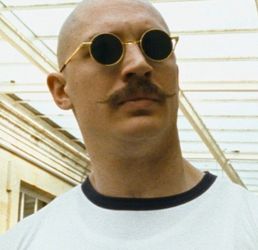 Tom Hardy portrays Britain’s most violent prison inmate, a man who refuses to cooperate.
Tom Hardy portrays Britain’s most violent prison inmate, a man who refuses to cooperate.
Bronson, the film from 2008 directed by Nicolas Winding Refn, is based on the life of an actual criminal named Michael Peterson, who gained a reputation as Britain’s most violent prison inmate, spending three decades in solitary confinement. During his last release on parole, he was employed as a bare-knuckle boxer, taking the name of tough-guy actor Charles Bronson. This may seem an unpromising subject for a movie, but from it Refn and his co-screenwriter Brock Norman Brock fashioned a portrait of savage unthinking rebellion, but the most important element is the man chosen to play Bronson—English actor Tom Hardy, who had made a name in theater and TV and a few supporting film roles before this part, which turned out to be his breakout into stardom.
A central device is having Bronson tell his story before a theater audience. In case there was any doubt, there are surreal touches that assure us that this is all in his imagination. Over time, his violent history has become part of a performance in his head for admirers that mostly don’t exist outside of it.
There is nothing out of the ordinary in his childhood to point to. At least Refn chooses not to try tracing Charlie’s problems to abuse of any kind, which isn’t to say that such things couldn’t have happened, but that trying to explain it in conventional terms is not the artistic point of the film. Instead we are invited to witness the horrifying and sometimes tragic inner life of an inveterate criminal without romanticizing it in any way.
It starts with the young man robbing a post office and being sentenced to seven years. What might have been four years with good behavior keeps getting extended because of the prisoner’s unwillingness to take orders from the guards. Although he’s never killed anyone, a fact that he lets us know early on, his physical attacks on others are punishing and unrestrained. Eventually he falls into a pattern of taking guards or other prison personnel hostage, then stripping naked and waiting for the billy club wielding guard units to break into his cell, where he fights them all barehanded.
So what’s this guy really like? On his last release, he shows that he wants a woman to love, but this is a feeling that is not returned. He also has no awareness of any of the rules needed in order to get by in society on even a minimal level. And eventually it turns out that he has an artistic bent, which causes a prison art teacher to overestimate his chances at rehabilitation.
In this film, however, we aren’t distracted with psychology, but always confronted with the raw presence of the man. Tom Hardy’s performance is an utter tour de force. He bulked up and transformed himself into Bronson so completely that you might forget that this is acting. And the key to the character, as Hardy embodies him, is simple, yet difficult to pull off. At Bronson’s core is an absolute refusal to recognize authority in any form, a loud and continuous NO to every attempt whatsoever to control him.
A lesser artist might have tried to make a hero out of Charlie, but we can only look on in dreadful fear at what a human being can become. The never deviating will of such a man, even to the point of self-destruction, has something stirring about it in a primitive way, something we can perhaps recognize from earliest childhood. Bronson captures the strangeness of a mind untouched by the trappings of civilized life.

Fellini’s first film as director, in collaboration with the veteran Alberto Lattuada, was this witty comedy about a small time traveling theater troupe. When...

A young black man yearns to reclaim the old San Francisco house that he grew up in, but which his father lost, in this...

Bong Joon Ho’s fiendishly clever new film takes aim at the issue of class, reflected in a tale of a family of criminals invading...